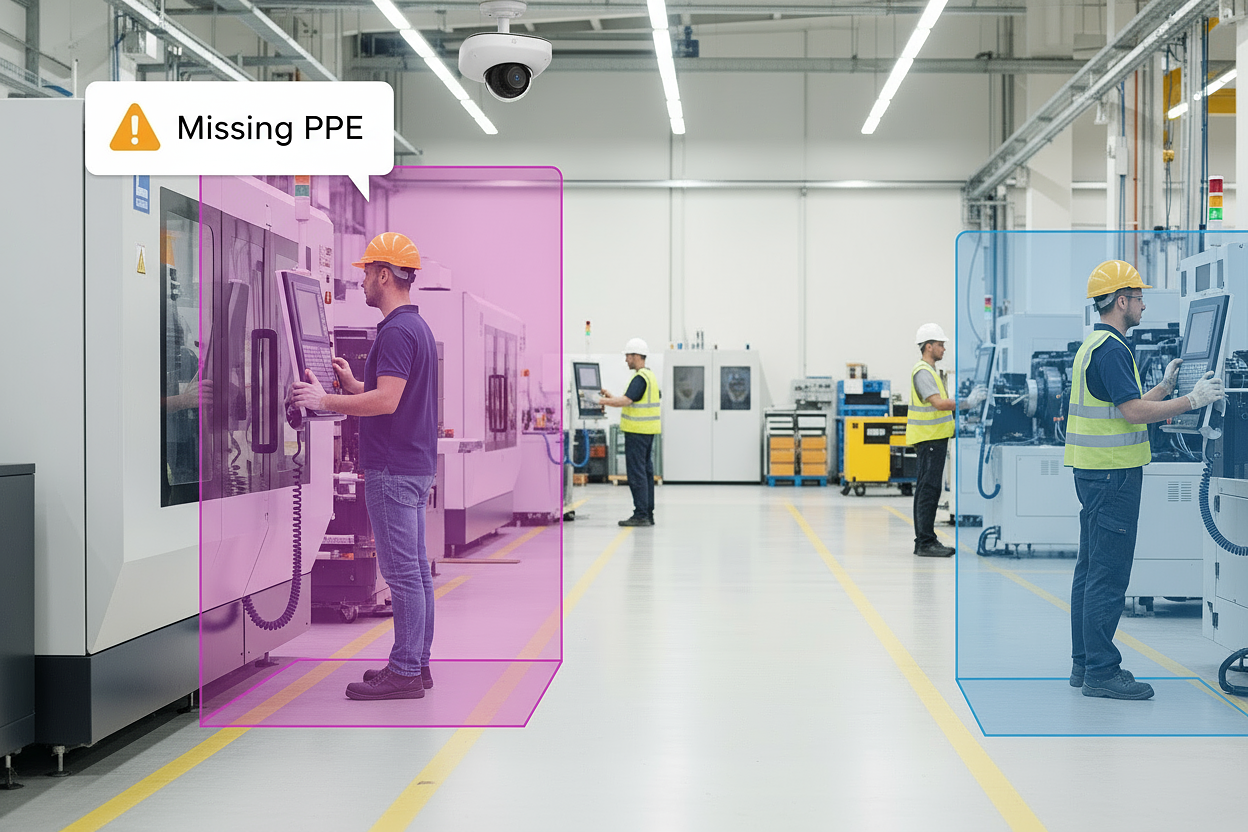Serious injuries in machinery manufacturing—including amputations, crush incidents, and lacerations—are far too common. Despite decades of progress, these avoidable incidents continue to impact workers and their families. The good news is that most of these injuries share a common thread: they can be avoided.
From entanglements in running machines to being struck by moving equipment, the risks are substantial, and the consequences can be severe. What’s more, the same top five injuries keep showing up in OSHA reports, costing companies not just in fines, but in lost productivity and team morale.
Fortunately, a combination of proven safety protocols and new technology like video AI analytics can help reduce these incidents. In this guide, we’ll walk through the top five avoidable injuries in machinery manufacturing, what causes them, and—most importantly—how a smarter, tech-supported safety approach can enhance worker safety.
The cost of safety negligence in machinery manufacturing
When safety takes a backseat, the penalties go beyond medical bills and lost workdays. OSHA fines for major violations can be substantial, but they don’t include indirect costs like retraining or lost output—which often exceed the initial fines by a wide margin.
By investing in robust safety programs—and leveraging video intelligence for early detection and intervention—manufacturers can address the root causes of these penalties.
The top 5 avoidable injuries in machinery manufacturing
1. Amputations and Crush Injuries

Scenario: A worker reaches into a jammed press to clear debris. The machine hasn’t been locked out. In seconds, a hand is caught, resulting in a severe injury.
Root Causes & Impact:
Unguarded moving parts are a primary cause of serious incidents.
Manual bypassing of safety systems is a common factor, often done to maintain production speed.
Lack of training makes new employees particularly vulnerable to injury.
Amputations are one of the most frequently reported serious injuries in the industry.
How video intelligence helps: Video AI cameras can flag when hands enter hazardous zones near running machines. Supervisors receive real-time alerts, allowing for timely intervention before an incident occurs.
2. Fractures and Traumatic Brain Injuries (from Struck-By Incidents)
Scenario: During a quick maintenance check on an elevated platform, an experienced operator skips the harness. A missed step at the edge results in a serious injury and hospitalization.
Root Causes & Impact:
A considerable number of fatalities occur from incidents on elevated surfaces during equipment maintenance.
Even experienced operators may neglect harness protection for tasks perceived as short or routine.
Struck-by injuries stem from falling parts or loads—like an overhead crane dropping a component.
Fractures (especially hips, legs, and skull) are among the top five reported injuries.
How video intelligence helps: Video AI can detect when workers enter elevated areas without harnesses. Automated alerts prompt supervisors to intervene for forward-looking coaching.
3. Cuts, Lacerations, and Avulsions

Scenario: A machine operator clears a jam from a high-speed cutter without powering down or donning protective gloves. A split-second slip leads to deep lacerations.
Root Causes & Impact:
Many incidents stem from blade contact and unguarded cutting zones.
Operators sometimes remove safety guards to fix jams quickly.
Cuts and lacerations are often severe, many requiring surgery or leading to permanent disability.
How video intelligence helps: Video analytics can monitor for unsafe hand positioning by flagging when a person enters a pre-defined danger zone. When a worker bypasses safety measures, the system triggers an alert that helps teams intervene.
4. Crushing and Struck-By Injuries (Material Handling Equipment)

Scenario: A worker using material handling equipment is caught between a heavy load and a rack. The result: severe crushing injuries.
Root Causes & Impact:
Heavy equipment like forklifts, cranes, and hoists are frequent sources of struck-by and crush injuries.
Poor visibility, lack of spotters, and rushed material handling intensify the risk.
Crushing incidents often involve severe trauma, hospitalizations, and sometimes death.
How video intelligence helps: Video AI can track vehicle and pedestrian movement, flagging dangerous proximity. With clear video evidence, supervisors can retrain teams and redesign workflows to enhance safety.
5. Burns, Electrocutions, and Environmental Exposures
Scenario: An electrician is troubleshooting a CNC machine with faulty wiring. There’s no arc-flash risk assessment, and the panel is energized. A sudden arc flash causes severe burns and hospitalization.
Root Causes & Impact:
Many facilities lack proper arc-flash assessments.
Contact with hot surfaces and exposure to chemicals are also leading causes of second- and third-degree burns.
Burns and electrocutions are serious incidents, with many requiring extensive treatment or resulting in fatalities.
How video intelligence helps: Video analytics can monitor for required PPE like hard hats and safety vests, flag unsafe access to electrical panels, and identify when workers enter restricted areas. Timely alerts mean teams can intervene before an incident occurs.
Practical Implementation of Safety Technology
Integration with existing safety programs: Video intelligence platforms like Spot AI work with your current camera systems. You don’t need to rip and replace—just add smarter analytics on top.
Customizable to your risks: Identify your injury hotspots—unguarded presses, high-traffic forklift lanes, elevated work platforms—and target those with video monitoring and real-time alerts.
Supports—not replaces—your team: AI doesn’t replace human oversight. It empowers your safety teams with timely information, so they can take action early.
Evaluating solutions: Look for platforms that are easy to deploy, provide search-friendly footage retrieval, and allow you to create custom safety “rules” that fit your workflows.
Ongoing refinement: Use incident video to retrain teams, refine processes, and strengthen your safety culture.
Ready to make your plant safer?
The right safety technology empowers your team to lead the way in injury mitigation. If you’re ready to take the next step, book a consultation with Spot AI. Let’s partner to build a safer, smarter machinery manufacturing workplace—where your people are always the priority.
Frequently Asked Questions
What are the most common injuries in machinery manufacturing, and how can their likelihood be reduced?
The top injuries include amputations, crush injuries, fractures, cuts/lacerations, and burns or electrocutions. Mitigation starts with strict machine guarding, enforced lockout/tagout, proper PPE, and robust training. Technology like video AI analytics adds a layer of risk reduction by flagging unsafe behaviors and helping supervisors intervene faster.
How can video analytics integrate with our existing safety programs?
Video AI platforms, such as Spot AI, typically work with your current camera infrastructure. They overlay analytics and real-time alerting, without requiring you to replace hardware. They support your safety team by making it easy to review incidents, spot trends, and enforce compliance.
What obstacles might we face when implementing safety technology in a manufacturing environment?
Common obstacles include resistance to change from staff and ensuring the technology fits existing workflows. Overcoming these requires clear communication, involving frontline staff in the implementation process, and choosing user-friendly platforms that don’t disrupt operations.
How can video AI help reduce material handling injuries?
Video AI tracks the movement of heavy equipment and workers. They can flag dangerous proximity and unauthorized access, helping supervisors redesign workflows and reinforce safe practices.
What are best practices for training teams to work with new safety technology?
Start with transparent communication about the “why”—emphasize risk reduction and empowerment, not surveillance. Offer hands-on demos, encourage questions, and use real incident footage (with privacy protected) for practical learning.
What is video AI for factory operations?
Video AI is technology that uses artificial intelligence to automatically analyze feeds from your existing cameras. It transforms passive video into an anticipatory safety tool by detecting specific objects like people or forklifts, unsafe behaviors like entering a restricted no-go zone, and missing personal protective equipment (PPE) like hard hats. This provides your team with real-time alerts and operational data, not just recordings.
What is the best video analytics for workplace safety?
The best system is one that aligns with your facility’s unique risks. Look for a platform that provides real-time, actionable alerts to help guard against incidents before they happen. It should also integrate easily with your existing cameras to control costs, allow you to create custom safety rules for specific danger zones, and offer powerful search capabilities to investigate incidents and analyze trends quickly.
About the Author
Joshua Foster is an IT Systems Engineer at Spot AI, where he focuses on designing and securing scalable enterprise networks, managing cloud-integrated infrastructure, and automating system workflows to enhance operational efficiency. He is passionate about cross-functional collaboration and takes pride in delivering robust technical solutions that empower both the Spot AI team and its customers.

























.png)
.png)
.png)